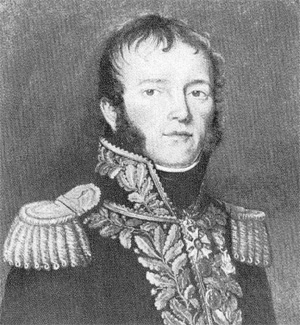General André Burthe

Born: December 8, 1772
Place of Birth: Metz, Moselle, France
Died: April 2, 1830
Place of Death: Paris, France
Arc de Triomphe: BURTHE on the north pillar
Pronunciation:
The son of a merchant, André Burthe first enlisted in the military in April of 1791 when he joined the 2nd Dragoons. Sent to the Army of the North, in March of 1793 he distinguished himself at Neerwinden and then a month later he was promoted to sous-lieutenant in the 10th Dragoons. The next year Burthe was wounded in another battle before joining the Army of the Rhine.
In February of 1796 Burthe was sent to the Army of Italy where he became an assistant to General Solignac. After serving throughout the campaign of 1796, in 1797 he was promoted to lieutenant and then capitaine. Burthe next became an aide-de-camp to General Masséna in the Army of Switzerland in 1798 and he served at the defense of the camp cut off from Zurich. 1799 saw Burthe promoted to chef d'escadron and then following Masséna to the Army of Italy. Continuing in his role as aide-de-camp to Masséna, he took part in the Siege of Genoa where he received two serious wounds. After the siege was concluded, Masséna gave Burthe the honor of taking the flags captured from the enemy to the First Consul.
Burthe next went to Holland, where he would remain for a few years until he was sent to Louisiana. Before Napoleon sold Louisiana to the United States, Burthe met a young Creole girl in New Orleans by the name of Marguerite Suzanne Delord Sarpy. They were married and she returned with him to France where she would follow him on campaign in a lieutenant's uniform as Monsieur d'Annelet, serving on his staff and fighting in the battles.1
Now back in France, Burthe was promoted to colonel of the 4th Hussars in early 1805. For the campaign against the Third Coalition, he served in Kellermann's division and both he and his wife served at the Battle of Austerlitz. The next year he joined Tilly's division in October and he served at Schleiz and Halle before being wounded at Liebstadt in January of 1807. That April Burthe joined Beaumont de Carrière's brigade and stayed with them, following them to Spain in 1808. After arriving in Spain, his wife decided she had had enough of campaigning and returned to Paris.2
Colonel Burthe was named a Baron of the Empire in 1808 and then in 1809 he took part in the Siege of Saragossa. He went on to fight at Maria and Belchité that June and then in October he charged the enemy at the crossing of the Sègre. In 1810 Burthe served at the bridge of Alventosa and fought at Lérida before being promoted to général de brigade at the end of the year.
General Burthe's next major assignment came in 1812 when he was placed in charge of the 2nd Brigade of Light Cavalry of II Corps in early 1812. He served on the campaign against Russia that year, eventually being transferred to Pajol's division and he was wounded at the Battle of Borodino. During the retreat, he was captured on November 15th and then held as a prisoner of war until after Napoleon's abdication in 1814.
Burthe returned to France in July of 1814 and he was soon put on non-activity. When Napoleon returned from exile for the Hundred Days, Burthe rallied to him and was given a command in the 5th Dragoon Division under General Strolz. That June he served in Belgium, charging at Fleurus on the 15th. On July 1st Burthe served at Vélizy in the last action of the Napoleonic Wars. Afterwards he was put on non-activity and he officially retired from the army in 1825.
Notes
- Simone de la Souchère Deléry, Napoleon's Soldiers in America, (Gretna: Pelican Publishing, 1950), 49.
- Ibid., 50.
Bibliography
- Divry, Arnauld. Les Noms Gravés sur l'Arc de Triomphe. Paris: L'Harmattan, 2017.
- Six, Georges. Dictionnaire Biographique des Généraux & Amiraux Français de la Révolution et de l'Empire (1792-1814). 2 vols. Paris: Gaston Saffroy, 2003.
Updated February 2022
© Nathan D. Jensen